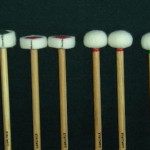My Instruments -Timpani Sticks
Ron Carlisle Mallets
It wasn’t until relatively late in my career with the Oslo Philharmonic Orchestra that I heard of Ron Carlisle and his hand-crafted timpani mallets. The year was 1994, and it was during a tour of the USA by the orchestra that this came about. It happened in Pittsburgh, at Heinz Hall. The orchestra had finished its sound-check rehearsal, and I went backstage to change for the concert. When I went back on stage to do a pre-concert check of the timpani, I found a pair of timpani mallets – encased in a plastic bag, with a note from one Ron Carlisle attached. It read – “Sorry I missed you. These mallets are for you. Try them out and let me know what think. – Ron.” Included was his business card. Apparently, he tried to get hold of me on stage between the rehearsal and concert and just missed me by a few seconds. I must admit that I was intrigued. The mallets turned out to be a pair of his standard wood-shaft Number 7 mallets – with a dome shaped core covered in green felt. I tried them out that very night, and was most impressed with them. The shafts were ½ inch in diameter and about fifteen inches long. Just a bit shorter than I was used to. But they felt really good. Little did I know that this was the start of a relationship (albeit a long-distance one) that would last for twenty-one years (and still counting). I contacted him from Oslo after our return, and thanked him for the courtesy while at the same time expressing my approval of the mallets and their characteristics. As a matter of fact, after my assistant tried them, we both agreed that the orchestra should have a complete set of his mallets – two sets – one for myself, and the other for my assistant. The purchase was made, and within two months both of us had a complete set of Carlisle Professional Timpani Mallets – with cherry-stain handles. They handled very well and we were pleased with them. However, the Olso Konserthus, while a beautiful hall to look at and a good home for the orchestra, was a notoriously difficult hall to play in. All of the sound went up, due to the lack of a proscenium. No matter how loud we played, or what size mallets we used, the sound did not project the way it should have. We checked our techniques, and it all came back to the lack of a proscenium, and the fact that there was a large choral space in back of the orchestra – in effect, another room behind the playing space. This led me to order some mallets that were 5/8 x16 in and even two pairs that were 5/8×17! These mallets also worked well, and they had a little more weight which helped in that hall.
Harry Teahan Mallets …and Ron Carlisle Bamboo Mallets
Harry Teahan was one of my very first students during my time as lecturer at Dartmouth College. He was about eight years younger than I, and incredibly talented. His energy and enthusiasm for music was unbounded. After I left Dartmouth, he studied with Bill Handley and later went on to a second degree- this one in music from Manhattan School of Music, also as a student of Dan Hinger. He even build a set of three Hinger-Anheier type cable timpani which were amazing instruments. He later became timpanist of the Trondheim Symphony Orchestra (1989-1995), and since 1995, has been the timpanist of the Copenhagen Philharmonic/Tivoli Orchestra. We kept in touch, and he made me several pair of bamboo-shafted mallets. They tended to have 5/8 shafts, and varied from between 14 and ½ inches and 16 inches in length. One experimental model was even longer – 17 inches, and the shafts were 6/8 in. in diameter. Harry and I called these the “Shillelaghs”. The ironic fact about these sticks is that their sheer weight made them perfect for soft but weighty tremolos – such as the final C roll at the end of the Verdi “Requiem”. I was very grateful to Harry and his skill. Those mallets were very useful in enabling me to project my tone in an acoustically difficult hall. Among the several pairs of mallets that he constructed for me was a pair that was based on a design originated by Dan Hinger. They were 15 and a half inches long and had ½ inch diameter shafts, and had surgical tubing for grips. The heads were large, round, with seams that were carefully marked to avoid “playing on the seams.” They were voiced to be a general-purpose type mallet, and they were among the best sticks that I ever had. I used them quite often, and remember using them for the opening of Sibelius’s 1st Symphony at a concert in Geneva, and getting a good review from the local music critic, who noted the “timpanist’s creamy tone.” These sticks still exist, and as a matter of fact, they became a template in the development of a line of timpani mallets made by Ron Carlisle. I was so taken with these mallets, that I asked Ron Carlisle if he could make two pairs of mallets – one a medium soft, and the other a medium hard – to complement the generals that Harry made for me. I gave him the specifications, and within weeks, I had the pairs in my possession, and they complimented the generals most successfully. I have used these three pairs over the years very successfully, and it wasn’t too long after this that Ron added a bamboo-shafted line to his selection. They had not morphed into the “Euro” line, but were a good step towards that evolution.
Here is a video clip in which I talk about the Teahan mallets.


Recent Comments